
Galapagos Angel – 8 Day Itinerary A

Day 1. NORTH SEYMOUR ISLAND
AM: Morning flight from Quito to Baltra, Galapagos Islands.
You will arrive at Baltra Island in the morning. After passing through immigration and baggage claim, you will be met by a Galapagos Angel staff member and transferred to the yacht. You will be shown to your cabin where you will have some time to settle in before lunch and a welcome briefing.

PM: North Seymour Island
In North Seymour you may see Galapagos sea lions, blue-footed boobies, and magnificent frigate birds which are abundant on this island. North Seymour was formed by a series of submarine lava flows containing layers of sediment that were uplifted by tectonic activity. The island is characterized by its arid vegetation zone.
Highlights: Land & marine iguanas, frigate birds, blue-footed boobies, sea lions, snorkeling: rays, reef sharks.
Activities: Dinghy ride & hiking (2.5 km)

Day 2. SANTIAGO ISLAND
AM: Chinese Hat Islet
This small islet is located near the southeast coast of Santiago Island. Its name comes from the distinct shape of the islet’s summit.
Chinese Islet is a great location to view many geological formations such as lava tunnels and lava flows. Some of the lava flows were formed underwater and subsequently raised above sea level. The presence of coral heads on the lava flow indicates this phenomenon.
Highlights: Lava formations, great site for snorkeling with an abundance of marine species such as sea lions, sharks, rays and Galapagos penguins.
Activities: Hiking (3 km)

PM: Sullivan Bay
Visit Sullivan Bay located on the southeast part of Santiago. This place is interesting for its geology because the area is covered by lava flows. This place has elevations in the form of small volcanoes formed by the lava flows.
Highlights: Lava flows, small volcanoes
Activities: Hiking
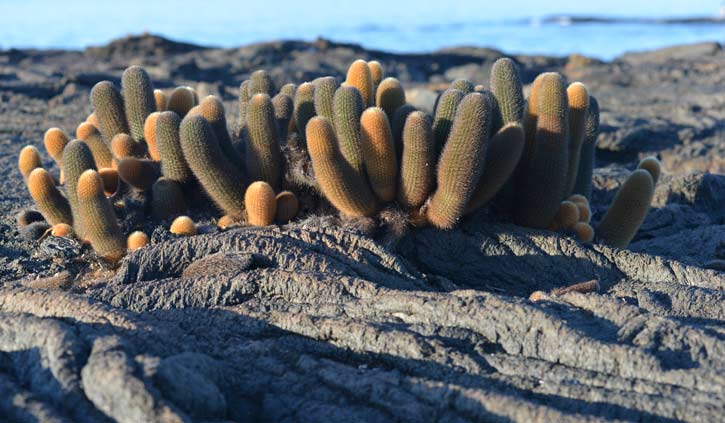
Day 3. GENOVESA ISLAND
AM: Darwin Bay
Visit the white-sand coral beach of Darwin Bay which includes a 0,75km trail that winds through mangroves filled with land birds. Nazca boobies, red-footed boobies, and swallow-tailed gulls, which can easily be spotted here. Further down the path we’ll find tidal pools where sea lions swim playfully. At the end is a spectacular view of a cliff.
Highlights: Nazca boobies, red- footed boobies, swallow-tailed gulls, mangroves, coral pebbles beach, snorkeling: rays, colorful reef fish and occasionally hammerhead sharks
Activities: Hiking (1.5 km), snorkeling, kayaking & dinghy
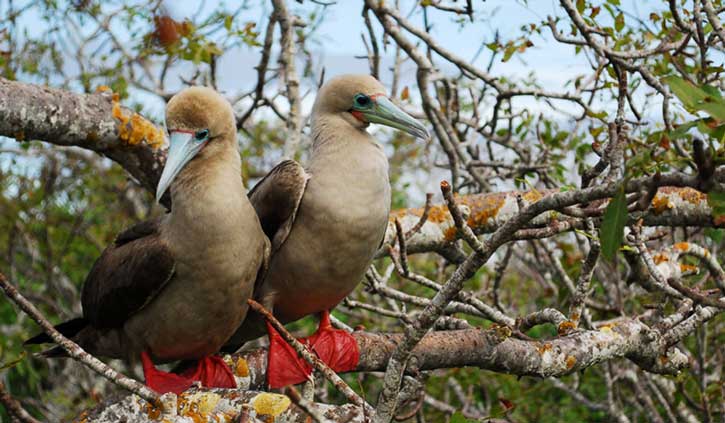
PM: El Barranco
El Barranco, also known as Prince Phillip’s Steps, is a steep, rocky path that leads up a high cliff rock face. A marvelous view can be appreciated from here. This site is also home to Palo Santo vegetation as well as red-footed boobies, short-eared owls, Galapagos storm petrels, and Galapagos doves.
Highlights: Red-footed boobies, short-eared owls, storm-petrels, Galapagos doves
Activities: Hiking (2km)

Day 4. SANTIAGO AND RABIDA ISLANDS
AM: Egas Port
Egas Port, also known as James Bay, on Santiago Island is home to the curious Galapagos hawks and quick-footed Galapagos lava lizards. The trail leads to the coastline with gorgeous tide pools and grottos full of fauna. Here the Galapagos fur seals bathe in the sun. This is also a great snorkeling site.
Highlights: Furseals, Galapagos sea lions, tidal pools and grottos, Galapagos hawks, oyster catchers, marine iguanas, finches. Snorkeling: reef sharks, turtles, rays and excellent underwater formations.
Activities: Hiking (2km) and snorkeling

PM: Rabida Island
Rabida Island (or Jervis) is one of the most colourful and volcanically varied islands in the archipelago as well as a great snorkeling site. We will start on Rabida’s famous maroon/red sand beach, and after an easy hike, you will arrive to a stunning lookout to enjoy the amazing landscapes. The island is a birdwatcher’s delight. Some species are abundant such as a few varieties of finches, Galapagos vermilion flycatchers, Galapagos hawks and brown pelicans.
Highlights: Snorkeling: white-cheeked pintail ducks, colourful fish, sea lions, brackish water lagoon, pelicans
Activities: Hiking (1 km) and snorkeling.

Day 5. SANTA CRUZ ISLAND
AM: Fausto Llerena Breeding Center
Today you visit “Fausto Llerena” Tortoise Breeding Center in Puerto Ayora, where giant tortoises are bred in captivity. This is home to tortoises ranging from 3-inches (new hatchlings) to 4-feet long adults. Subspecies of the giant tortoises interact with one another, and many of the older tortoises are accustomed to humans stretching out their heads for a photo opportunity. The babies are kept until they are about four years-old and strong enough to survive on their own.
Highlights: Giant tortoises, finches, Galapagos rails
Activities: Easy Walks
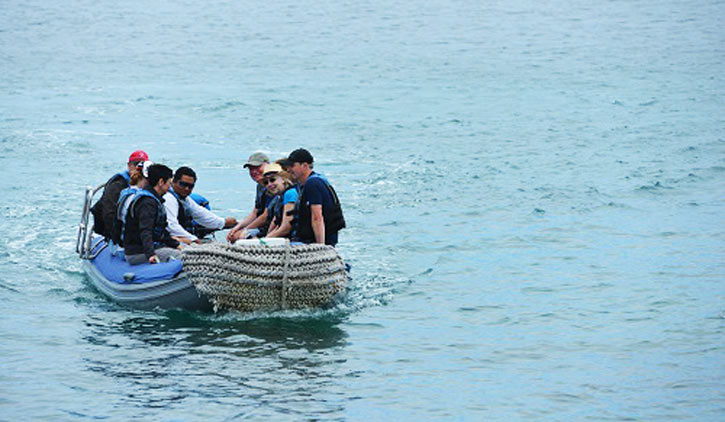
PM: Highlands
Accessible by bus from Puerto Ayora, the highlands of Santa Cruz are a deep green which contrast beautifully with the dry, lower part of the islands. The predominant vegetation in the highlands are Scalesia trees which create a lush green forest. The lava tunnels, over half a mile long, are underground and walking through them is a unique, surreal experience. At this place you’ll have lunch.
Highlights: Lava tunnels, finches, wild tortoises, tortoise nesting site
Activities: Hiking (2.5 km)

Day 6. ESPANOLA ISLAND
AM: Suarez Point
On the trail to Suarez Point, you will have the chance to spot blue-footed boobies, albatrosses, and Nazca boobies. The island is the breeding site of nearly all of the world’s 12,000 pairs of waved albatrosses. You will also visit a beautiful site on the ocean front where there is a cliff that the large albatrosses use as a launching pad! You will have the chance to see the famous blowhole that spurts sea water into the air. The landscape is great for photography.
Highlights: Waved albatrosses, Nazca and blue-footed boobies, blowhole, lava lizards
Activities: Hike (3 km)
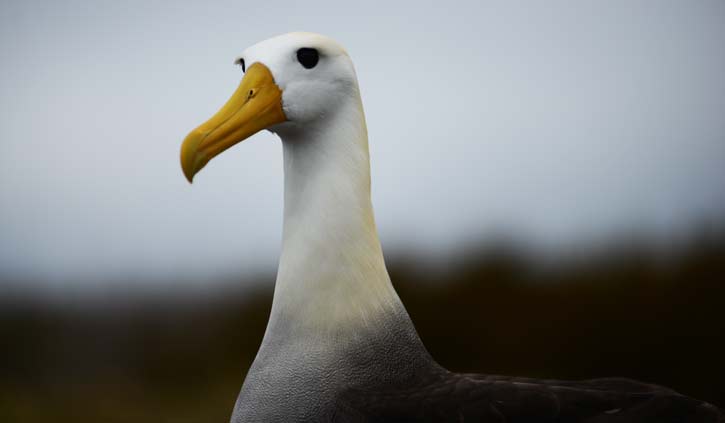
PM: Gardner Bay, Gardner Islet and Osborn Islet
This excursion takes you to the spectacular Gardner Bay. After landing, you can walk across a lovely white-sand beach amongst a busy sea lion colony or dive into the water to swim with sea lion pups. You may also see curious mockingbirds on the beach.
Highlights: White sandy beach, sea lions, mockingbirds, colourful fish, sea lion nursery
Activities: Snorkeling, panga ride, kayaking, short hike (1 km)

Day 7. SANTA FE AND SOUTH PLAZA ISLANDS
AM: Santa Fe Island
Santa Fe Island (Barrington) is home to the small picturesque bay and anchorage on the island’s northeast coast. The bay has two visitor trails: one leading to a scenic viewpoint atop a cliff, and the other spanning from a small beach to a tall prickly pear cactus forest.
Highlights: Land iguanas, giant Opuntia cacti
Activities: Hike (8 km)

PM: South Plaza Island
This small island with steep cliffs was formed by rising lava and is now covered by Opuntia cacti. It is also home to one of the largest sea lion colonies as well as colorful yellow and red land iguanas. The most characteristic plant is the Sesuvium. During the rainy season its color is a greenish to yellowish tone and in the dry season (end of June through January) a bright red.
Highlights: Land iguanas, sea lion colony, Nazca boobies, cliff landscape
Activities: Hike (2.5 km)

Day 7. MOSQUERA ISLET
AM: Mosquera Islet
Mosquera Islet is located between the islands of Baltra and North Seymour. This reef of rocks and coral (the result of an uprising) is only 160 meters across at its narrowest width. This island has one of the largest populations of sea lions and is home to many shorebirds. There have been occasional reports at this site of orcas feeding on sea lions
Highlights: Orcas, sea lions, shore birds
Activities: Dinghy ride, snorkeling
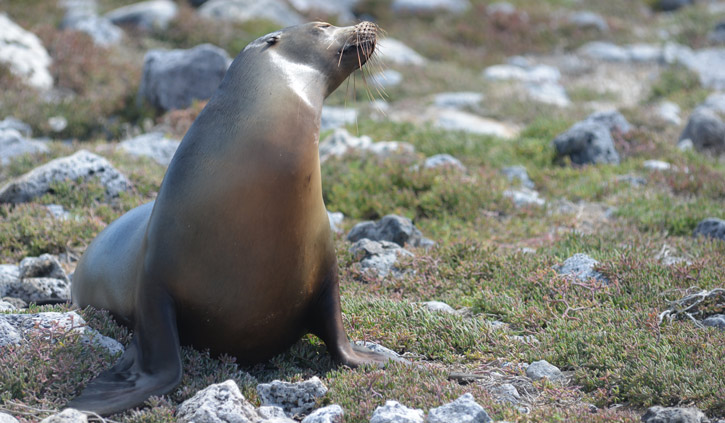
Baltra Airport Departure
After this final visit, you will be transferred to the Baltra airport in time for your flight back to the mainland.

Ready to Book?
To book this voyage call 1300 860 859 or email contact@galapagoscruisetravelcentre.com.au

